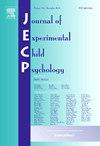孩子们从别人的面部表情中推断出与事实不符的信息
IF 1.8
2区 心理学
Q3 PSYCHOLOGY, DEVELOPMENTAL
引用次数: 0
摘要
当别人感到后悔和宽慰时,能够识别出来,这对调整我们自己的行为以及在试图采取亲社会行动时是有益的。虽然孩子们在6岁左右开始对自己感到后悔和宽慰,但他们是否能识别出他人身上的这些反事实情绪,目前还不清楚。在两项研究中,我们调查了4至9岁的儿童(N = 192,主要是澳大利亚人和社会经济优势,数据收集于2023年)在做出导致更好或更坏结果的决定后,是否能识别他人的遗憾和宽慰。孩子们观看了四个不同的成人演员在两个盒子里选择不同数量的饼干的视频。每个演员首先看着选定的盒子,做出高兴或悲伤的面部表情,然后给孩子们看演员选择的盒子里的东西。关键的是,演员看了看没有选择的盒子,然后再次做出快乐或悲伤的面部表情,然后问孩子们他们认为盒子里有什么。在这两项研究中,许多6岁及以上的儿童推断,当演员做出悲伤的表情时,未选择的盒子里的饼干比选择的盒子里的饼干更多。然而,当演员做出快乐的表情时,孩子们不太可能推断出没有选择的盒子里的饼干比选择的盒子里的饼干少。总的来说,这些发现表明,从6岁左右开始,孩子们就可以从别人的面部表情中推断出与事实相反的信息,而且孩子们可能更容易识别出遗憾,而不是宽慰。本文章由计算机程序翻译,如有差异,请以英文原文为准。
Children infer counterfactual information from others’ facial expressions
Being able to identify when other people experience regret and relief can be beneficial for adapting our own behaviour and when trying to act pro-socially. Although children begin to experience regret and relief for themselves around age 6, it remains unclear whether they can recognise these counterfactual emotions in others. Across two studies, we investigated if 4- to 9-year-old children (N = 192, mostly Australian and socioeconomically advantaged, data collected in 2023) could identify others’ regret and relief after making a decision that led to a better or worse outcome. Children watched videos of four different adult actors choosing between two boxes that concealed different amounts of cookies. Each actor first looked inside the chosen box and made a happy or sad facial expression, and children were then shown the contents of the actor’s chosen box. Critically, the actor then looked inside the non-chosen box and again made either a happy or sad facial expression, before children were asked what they thought was inside that box. In both studies, many children aged 6 years and older inferred that the non-chosen box contained more cookies than the chosen box when the actor made a sad face. Children were less likely, however, to infer that the non-chosen box contained fewer cookies than the chosen box when the actor made a happy face. Overall, these findings suggest that from around 6 years of age children can infer counterfactual information from others’ facial expressions, and that children may more readily recognise regret than relief.
求助全文
通过发布文献求助,成功后即可免费获取论文全文。
去求助
来源期刊

Journal of Experimental Child Psychology
Multiple-
CiteScore
4.50
自引率
7.70%
发文量
190
期刊介绍:
The Journal of Experimental Child Psychology is an excellent source of information concerning all aspects of the development of children. It includes empirical psychological research on cognitive, social/emotional, and physical development. In addition, the journal periodically publishes Special Topic issues.
 求助内容:
求助内容: 应助结果提醒方式:
应助结果提醒方式:


